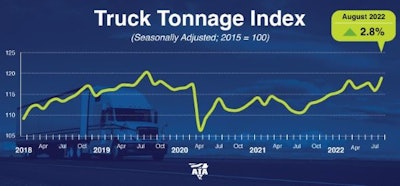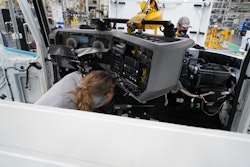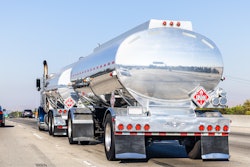Trucking news and briefs for Thursday, Sept. 22, 2022:
ATA truck tonnage increased in August

“Tonnage snapped back in August after a weaker than expected July,” said ATA Chief Economist Bob Costello. “With the economy in transition to slower growth and changing consumer patterns, we may see more volatility in the months ahead. But the good news is that we continue to witness areas of freight growth in consumer spending and manufacturing, which is helping to offset the weakness in new home construction.”
Compared with August 2021, the SA index increased 7.4%, which was the twelfth straight year-over-year gain and the largest increase since June 2018. In July, the index was up 4.7% from a year earlier. Year-to-date through August, compared with the same period in 2021, tonnage was up 3.9%.
The not seasonally adjusted index, which represents the change in tonnage actually hauled by fleets before any seasonal adjustment, equaled 124.6 in August, 8.2% above the July level (115.1). In calculating the index, 100 represents 2015. ATA’s For-Hire Truck Tonnage Index is dominated by contract freight as opposed to spot market freight.
FMCSA planning study on driver involvement in autonomous trucks
The Federal Motor Carrier Safety Administration, in a notice published Wednesday in the Federal Register, announced it will be conducting a driving simulator study with a series of questionnaires that will evaluate how commercial motor vehicle drivers engage with trucks equipped with automated driving systems.
The study comes on the heels of FMCSA, with sister agency NHTSA, exploring an autonomous-truck crash in the fleet of the TuSimple company in which operator engagement may well have played a role.
FMCSA said approximately 100 drivers will participate in the new study, which will examine the effect of non-driving secondary task engagement, transfer of control, and training on driver behavior in trucks equipment with Automated Driving Systems (ADS) tech.
[Related: TuSimple legal chief steps down, company subject of class action lawsuit]
In its Federal Register notice, FMCSA said Society of Automotive Engineers (SAE) Level 2 (L2) and Level 3 (L3) automated driving systems “present an environment that is ripe for overreliance.” Level 2 ADS trucks offer support to the driver, but the driver is still responsible for driving at all times. “At this level, engaging in non-driving secondary tasks can be highly detrimental to driving performance, as the driver may not recognize and respond to hazards timely or appropriately,” FMCSA noted.
In a Level 3 autonomous truck, “the role of distraction is blurred,” the agency said. “The driver takes on a more supervisory role and is in full control of the vehicle in a limited number of situations.” When a driver is alerted that a takeover is required in an L3 truck, FMCSA added, “the driver needs to have situational awareness to resume full control of the vehicle.”
Engaging in non-driving secondary tasks could prevent that situational awareness, the agency noted.
FMCSA is now looking to obtain more data to evaluate driver readiness to assume control in SAE L2 and L3 trucks, and develop and test a truck driver distraction training program to help improve driver readiness.
The White House Office of Management and Budget (OMB) has to approve the information collection request before the study begins. FMCSA said 50 drivers will participate in the L2 study sessions, and another 50 drivers will participate in the L3 study sessions.
Volvo testing fuel-cell electric trucks with 600-plus mile range in Europe
 Volvo will conduct a second pilot phase in 2025 in which customers will test fuel-cell electric trucks in Northern Europe.
Volvo will conduct a second pilot phase in 2025 in which customers will test fuel-cell electric trucks in Northern Europe.
The testing of fuel-cell electric trucks in commercial traffic will start in 2025 with selected customers in Northern Europe, followed by additional trucks in more countries over the coming years.
Hydrogen-powered fuel-cell electric trucks will be especially suitable for long distance and heavy, energy-demanding assignments, Volvo said. They could also be an option in countries where battery charging possibilities are limited.
“I believe that the pilot tests will highlight the potential for fuel cell electric trucks," said Jessica Sandström, SvP Global Product Management at Volvo Trucks. "The tests will run in a demanding, harsh climate and it also give us a great opportunity for driving with heavy loads up 65 tons.“
The goal of the pilot tests will be to look at all different aspects of the truck’s operation, including working components, handling and driver experience.
A fuel cell generates its own electricity from the hydrogen onboard instead of being charged from an external source. The only biproduct emitted is water vapor. Volvo’s electric trucks will use two fuel cells with a capacity to generate 300 kW of power and will have a refuel time of less than 15 minutes.
The fuel cells will be supplied by Cellcentric -- the joint venture between the Volvo Group and Daimler Truck AG. Cellcentric will build one of Europe’s largest series production facilities for fuel cells, especially developed for heavy vehicles.













